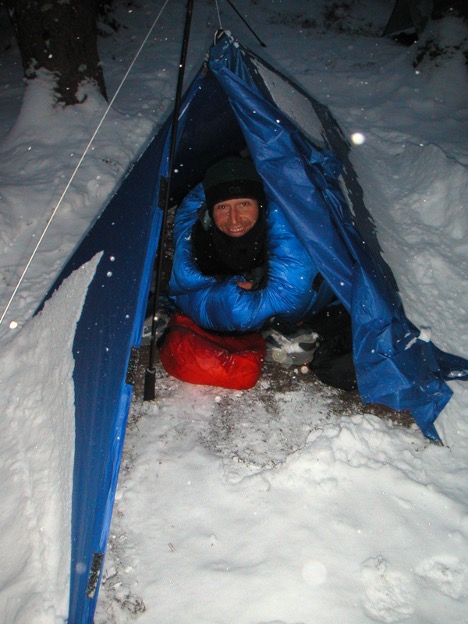Quilt v. Sleeping Bag
Lots of people trade in their down sleeping bag for a quilt to save weight. While I may be missing something, the math doesn’t make sense to me, at least for my sleeping situation. Quilts may have some advantages, but I would argue that saving weight is not one of them.
The typical quilt seems to have some kind of toe box, and then an open bottom, with some kind of strap system to attach it to your sleeping pad, and no hood. I get that not having down underneath you, where the weight of your body compresses it and renders it essentially useless for insulation. And if you have a pad anyway, it makes total sense to use that as part of your sleeping system and eliminate the bottom of your sleeping bag. However, I’ve observed that many quilts seem to be designed so that, when snugged completely up, basically the two sides butt up to each other on the bottom, negating the weight savings of ‘no down on the bottom’.
My sleeping bags, custom sewn by Nunatak back in the day, also have no down on the bottom. After a generous toe box, the bottom 16” width of the bag is a single piece of nylon. This accomplishes the goal of saving weight by not having down on the bottom, with the added benefits of no gaps for heated to escape from, or for bugs or cold air to get into, without the hassle of straps. Since my sleeping pad is a torso pad of 3/8” foam, it doesn’t provide the structure necessary to strap a quilt to. But it’s perfect for slipping under my sleeping bag. And my sleeping bag has a generously insulated, integrated hood, which I find to be crucial for optimal insulation. Admittedly, since I no longer have significant hair on my head, I may be a little more sensitive to heat loss in this area than others.
- The benefits I hear touted for quilts are generally:
Weight Savings
Sure, if you take off the hood and zipper from a sleeping bag, you’re bound to save some weight. But, if the bag is wide enough that you can completely enclose the bottom, then you’re not really saving the weight of the bottom. Plus you have to include the weight of the straps. And if you have to carry a heavier hat, that’s warm enough to insulate your head at night rather than just while you’re moving, and have the hood of another garment over that, then you have to count the weight of that extra, or heavier hat against the supposed weight savings. - Ability to use as a Blanket in Warmer Temps
Being too warm on a backpacking trip is not something I have a lot of memories of. True, I do have a couple of sleeping bag choices, so I can tune my bag choice somewhat to the anticipated temps. But even with my bag, having no zipper, I’ve been able to regulate temps by starting the evening with the bag pushed down to my waist. When my core cooled, I pulled the bag up to my armpits, later further up to cover my shoulders, and finally to cover my head with the hood.
So ounce for ounce, for a given effective insulation value, I think an enclosed down bag, with a single nylon layer on the bottom, no zipper and a full hood, is the clear winner. True, the benefit of an integrated hood and the attendant efficiencies does carry some drawbacks. It’s perfect for sleeping on your back. However I, like many people I suspect, switch back and forth all night between back and either side. On my side, I’ve had to become adept at breathing out of one corner of the hood opening, since it doesn’t swivel. For me that’s a fair tradeoff for the thermal efficiency of an integrated hood, but others may come to other conclusions.
